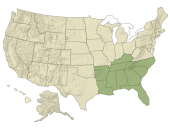 Everglades National Park, the largest remaining subtropical wilderness in the United States, is actually a patchwork of habitats extending from the outskirts of suburban Miami to Florida’s Gulf Coast. With a half-million acres underwater, the park claims the biggest protected mangrove forest in the Western Hemisphere. Combining history with wildlife, the Natchez Trace National Parkway wends its way across 444 miles and three state lines: an 800-foot-wide ribbon of green with a roadway running through it from the foothills of the Appalachians in Tennessee to the bluffs of Natchez, Miss.
Everglades National Park, the largest remaining subtropical wilderness in the United States, is actually a patchwork of habitats extending from the outskirts of suburban Miami to Florida’s Gulf Coast. With a half-million acres underwater, the park claims the biggest protected mangrove forest in the Western Hemisphere. Combining history with wildlife, the Natchez Trace National Parkway wends its way across 444 miles and three state lines: an 800-foot-wide ribbon of green with a roadway running through it from the foothills of the Appalachians in Tennessee to the bluffs of Natchez, Miss.
 Try it on your smartphone!
Try it on your smartphone! Try it on your smartphone!
Try it on your smartphone!